
Credit: New South Wales National Parks and Wildlife Service
Background
Synopsis: Thought to have been extinct for over 2 million years, a cluster of Wollemi pine was discovered by hikers in a secluded canyon outside of Sydney, Australia in 1994. Guarding this area from humans and fire along with cultivation and conservation efforts by botanical gardens have safeguarded this unique species. Now, advances in decoding the Wollemi pine genome may provide the secret to successfully preserve this critically endangered species.
- Scientists observed evidence of Wollemi pines in fossils dating back 91 million years, but until recently believed them to be extinct.
- In 1994, a Parks and Wildlife officer in the Wollemi National Park, about 37 miles from Sydney, encountered a canyon filled with large pine trees of a species he didn’t recognize. The trees had fern-like leave and a very lumpy bark.
- He took samples to a naturalist who assumed they came from a fern but was shocked to hear that they were collected from a tree over 100 feet tall (30.5 meters).;
- Researchers came to the park to study the tree and announced they had discovered a new species.
- Soon, media outlets and the public gave the tree celebrity status, yet the location was kept secret to prevent tampering with research and the trees themselves.
- Paleobotanists compared the trees to fossils discovered the year before and realized that the new species had in fact existed for 90 million years and was thought to have gone extinct two million years ago. They reached their peak abundance roughly 34 to 65 million years ago.
- They dubbed the tree Wollemia nobilis, after the park it was found in and the park ranger who discovered it, David Noble.

Green leaves of a Wollemi pine next to a fossil of ancient Wollemi pine leaves.
Credit: Jamie Plaza, Botanic Gardens Trust, via NSW National Parks and Wildlife Service
- Commonly called the Wollemi pine, it’s easily one of the rarest trees in the world, with less than 100 trees left in the wild.
- Wollemi pines are not true pines, as their genus is really Araucariaceae, a family of conifers that are primarily found in the Southern hemisphere but were spread globally during the Jurassic and Cretaceous periods.
- One tree has many trunks, due to a process called coppicing, when younger stems emerge and replace the older ones over time.
- These trees can get up to 130 feet (40 meters) tall and can live to be hundreds or even thousands of years old.
- They have red-brown bark that is bubbly and textured, and needles that are a light green and thicker than other conifers’ needles. Both female and male cones grow on the trees, with female cones being rounded and higher up on the tree, and male cones being narrower.
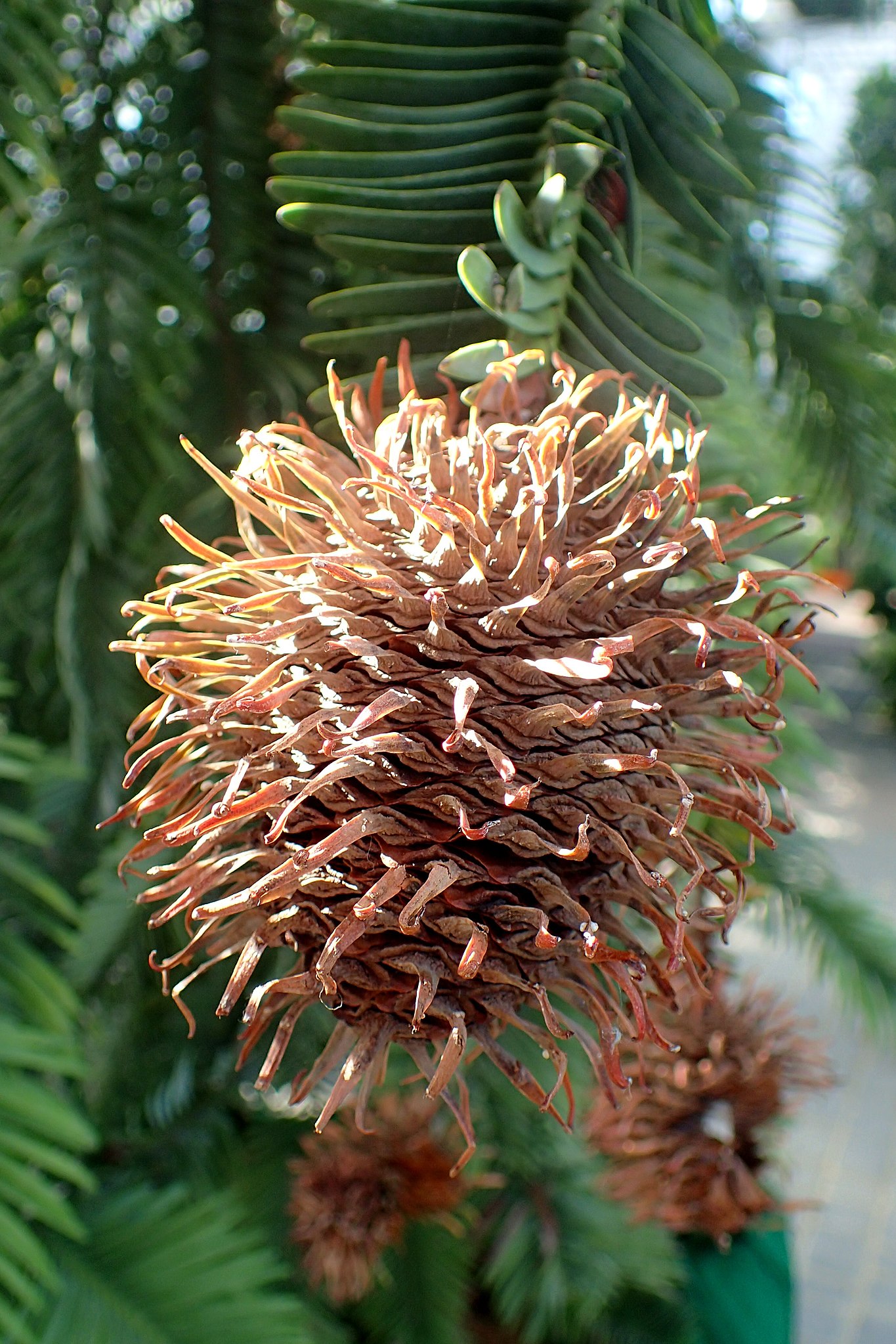
The round female cone of the Wollemi pine is found near the top of the tree.
Credit: https://commons.wikimedia.org/wiki/File:Wollemia_nobilis_kz4.jpg, CC BY-SA 4.0, via Wikimedia Commons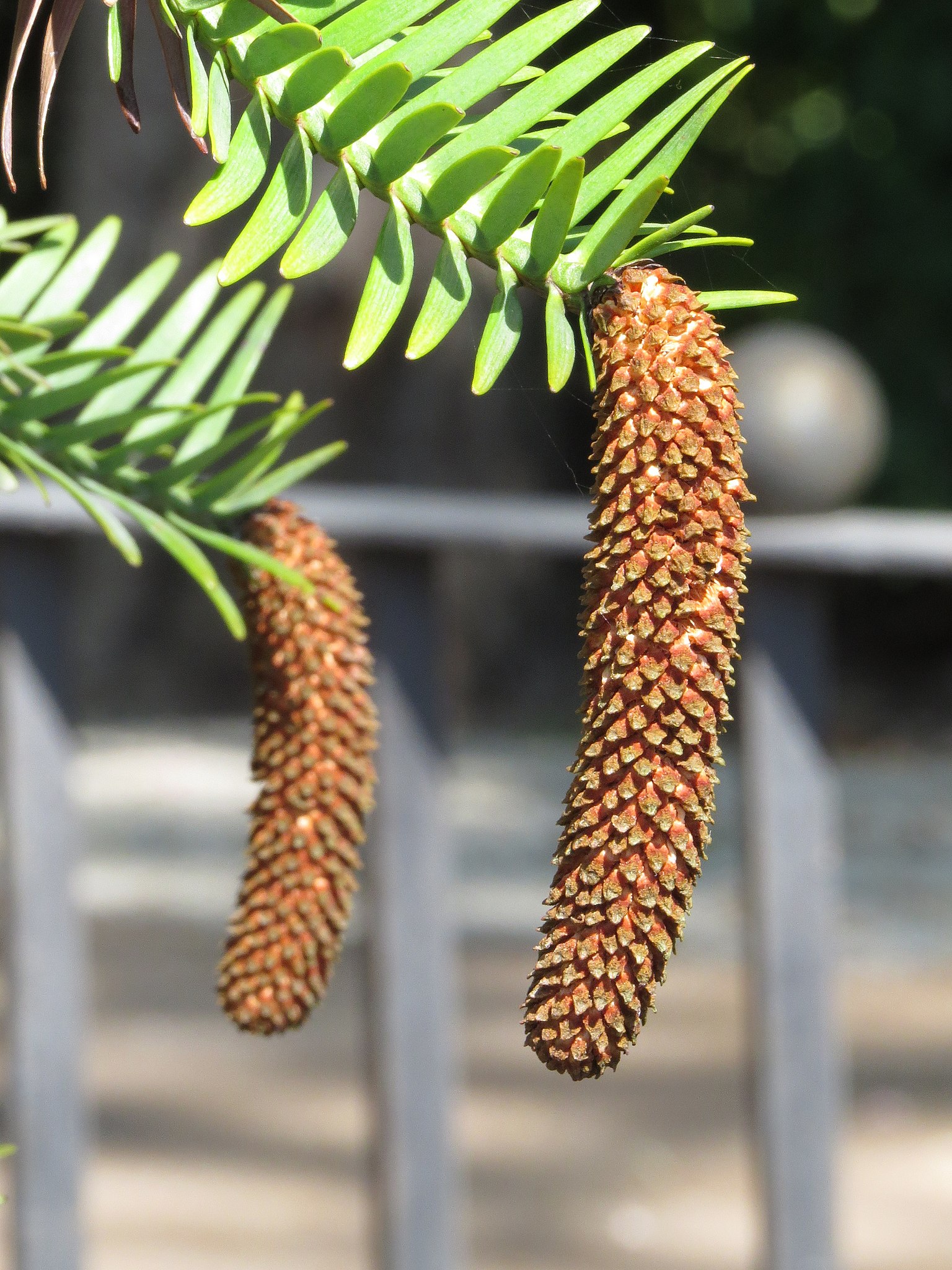
The elongated male cone of the Wollemi pine is found on the lower branches of the tree.
Credit: Adrian198cm, CC0, via Wikimedia Commons - There is a fungus that lives inside the Wollemi pine that has been found to produce an anti-cancer agent, Taxol, suggesting pharmaceutical uses for the trees like the other plants containing the chemical.
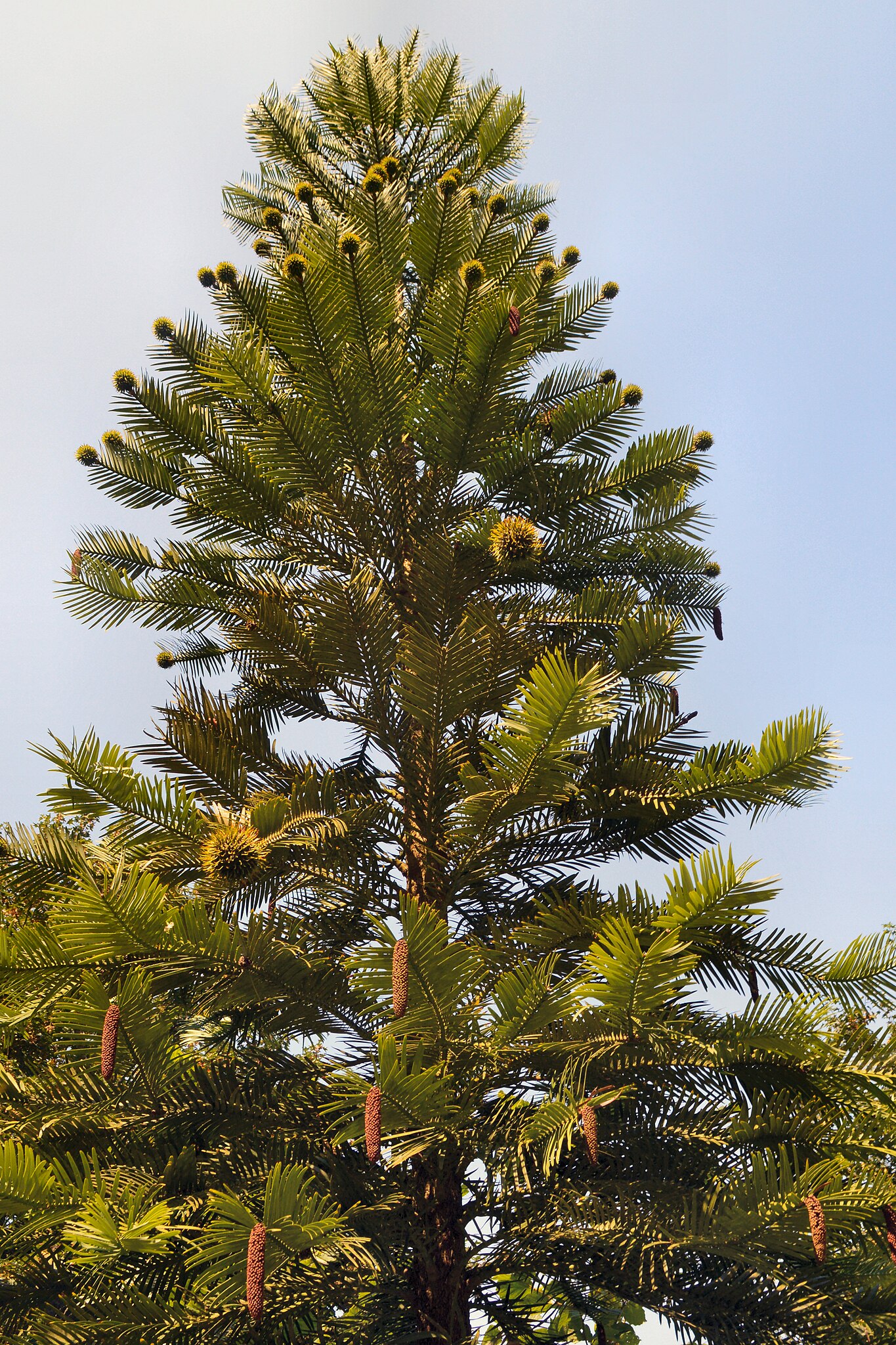
The Wollemi’s unique foliage, green female cones and brown male cones on display at Wakehurst Place Botanical Gardens south of London, England.
Credit: AndyScott, CC BY-SA 4.0, via Wikimedia Commons
- The Wollemi pine can withstand a wide range of cold and warm temperatures, but it has a significant risk of becoming endangered in the wild.
- Fires are a huge threat to the Wollemi pine. The 2020 Gosper’s Mountain mega-fire required extensive effort to save the grove of pines. Sprinklers, firefighters, and other safety measures saved all but two of the trees from a massive bushfire, although many others were charred. An emergency plan has been set up to prevent further damage.
- To prevent visitors from tracking in harmful pathogens, the area around the trees is a public exclusion zone, and tampering with them leads to a fine or even prison time.
- A team of researchers from Australia, the United States, and Italy have recently completed decoding the genome of the Wollemi pine with the hope of understanding the unique evolution and reproductive habits of this rare plant.
- Scientists discovered Wollemi pines have 26 chromosomes, significantly more than humans, but significantly less genetic diversity.
- A harmful mutation and subsequent population collapse, called a bottleneck, could explain both the rarity of the trees and the genetic non-diversity among them.
- Wollemi pines have evolved to reproduce asexually with suckers, branches that grow upright from the root, emerging and becoming a new tree.
- As opposed to sexual reproduction, asexual reproduction reduces the chances of more harmful mutations, but also slims the gene pool as the trees essentially clone themselves.
- Decoding the genome also revealed why Wollemi pines are also incredibly susceptible to disease. Pathogens causing root rot or similar problems easily kill juveniles of the species. The RNA of the trees, which gives them their unique thick needles, unlike other conifers, also suppresses their disease-resistant genes.
- Understanding these strange mutations, genes, and reproductive patterns can further assist with the conservation of the fragile population of Wollemi pines.
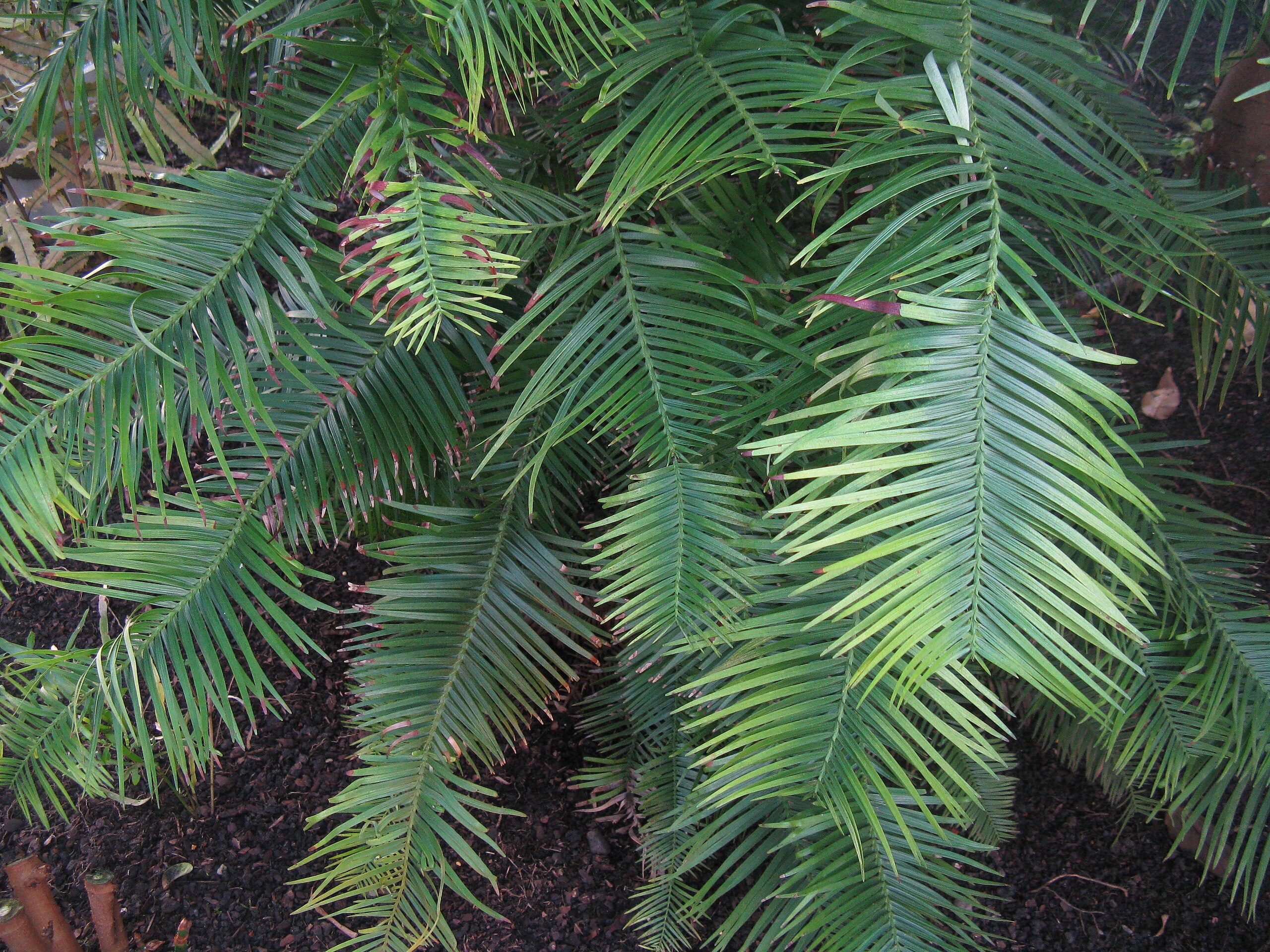
The Wollemi pine has wide needles compared to other types of conifers.
Credit: M J Richardson, CC BY-SA 2.0, via Wikimedia Commons
- The media attention around the critically endangered Wollemi pine has led not only to significant funding, but also has helped pave the way for protections for other endangered plants.
- Worried that the Wollemi pine would go extinct, scientists gave saplings to botanical gardens around the world, and eventually made them available commercially.
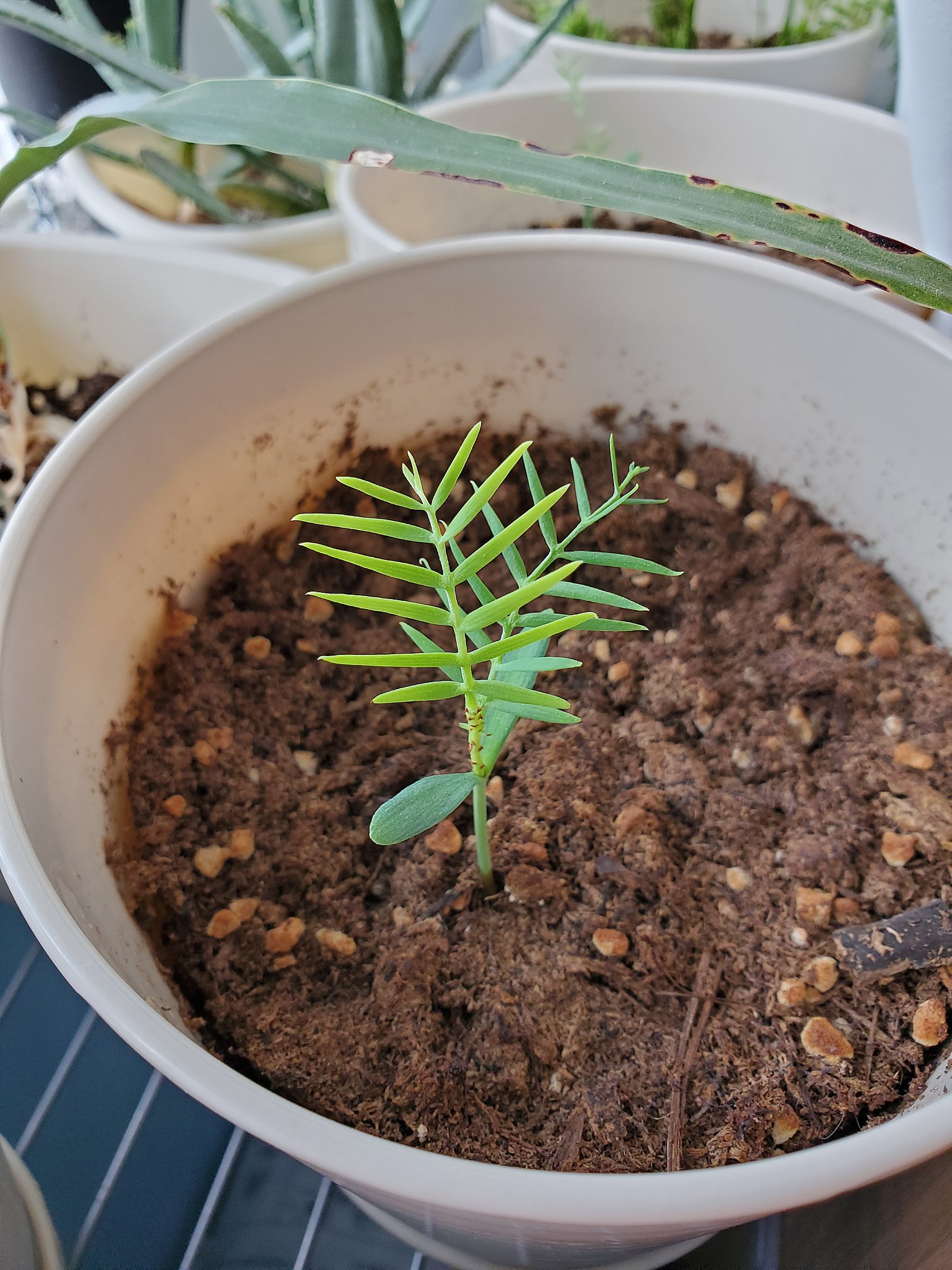
Conservation efforts are making seedlings of Wollemi pines available to botanic gardens and homeowners.
Credit: Pc1878, CC BY-SA 4.0, via Wikimedia Commons - Meanwhile, researchers are trying to reintroduce genetic diversity in the population.
- Forty percent of plant life on Earth is at risk of extinction, but endangered animals are much more popular with the public, leaving this issue largely unnoticed.
- The work with Wollemi pines provides hope that soon other endangered plant species will get similar care, threat management and legislation to preserve them.
- Worried that the Wollemi pine would go extinct, scientists gave saplings to botanical gardens around the world, and eventually made them available commercially.
Episode Script
Imagine you’re a park ranger, hiking your territory, when you discover a grove of trees unlike any you’ve ever seen before.
That’s exactly what happened in Wollemi National Park near Sydney. The trees were huge yet had fern-like leaves. Sort of like a pine, but not quite.
So the ranger took a sample to some scientists … who were also baffled. Until one compared it to a fossil tens of millions of years old—and it was a dead ringer.
Very dead! This tree had supposedly gone extinct 2 million years ago! Yet miraculously, just outside Australia’s biggest city, this grove had survived, undetected.
The so-called Wollemi pine became a media sensation, but scientists were so worried about human impact, or fire, they kept the grove’s exact location a secret.
Researchers studying the ‘pines’ found them unique indeed. Each tree has multiple trunks, which can reach over 100 feet tall, and live a thousand years. A fungus within them produces an anti-cancer agent.
Each tree has both male and female cones, to reproduce sexually. Or asexually, when their roots send up new shoots.
With only 100 individual trees left in the wild, researchers sent saplings to botanical gardens to prevent them from actually going extinct—a success story for endangered plant species.
And a reminder that new scientific discoveries await for those who take the time to observe.

